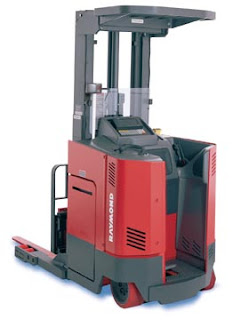Stick a Fork in It
 I’ve never driven a forklift, and I’ve also never been fortunate enough to have been injured at work. It would be nice to collect from the worker’s compensation carrier and then have the luxury of filing suit against some third-party. Tashee Parker was employed by Home Depot at one of its distribution centers. Mr. Parker was hurt when the forklift he was driving collided with a pallet jack, injuring his foot. The Supreme Court in Orange County, New York, in Parker v. Raymond Corp., No. 2005/7189, 2010 WL 1999529 (N.Y. Sup. Ct. May 17, 2010), recently terminated Mr. Parker’s case against the forklift manufacturer via summary judgment.
I’ve never driven a forklift, and I’ve also never been fortunate enough to have been injured at work. It would be nice to collect from the worker’s compensation carrier and then have the luxury of filing suit against some third-party. Tashee Parker was employed by Home Depot at one of its distribution centers. Mr. Parker was hurt when the forklift he was driving collided with a pallet jack, injuring his foot. The Supreme Court in Orange County, New York, in Parker v. Raymond Corp., No. 2005/7189, 2010 WL 1999529 (N.Y. Sup. Ct. May 17, 2010), recently terminated Mr. Parker’s case against the forklift manufacturer via summary judgment.
Parker alleged that the forklift had a design defect. What he didn’t know at the outset was that the forklift was “first developed by Raymond in the 1940s.” Also, the design and manufacture of the forklift are “subject to certain design and safety standards . . . which . . . have been incorporated into Federal regulations. . . . The subject forklift meets or exceeds all such requirements and standards.” If you are a plaintiff, it is not a good sign when the court points out that the equipment that you claim has a design defect has been around for more than 60 years and exceeds the necessary regulations. The forklift probably doesn’t have a design defect. Most likely. Someone probably would have found it before you, Mr. Johnny-come-lately plaintiff.
It comes as no surprise to most of us that plaintiffs regularly make fantastical arguments. Usually, these fantastical arguments succeed in defeating summary judgment, allowing the plaintiff to settle his lawsuit for more than it is worth. The New York Supreme Court did not buy what the plaintiff was selling. Plaintiff argued that the forklift should have been made with a “foot guard” to “facilitate the operator’s ability to safely remain within the confines of the compartment,” even though Plaintiff admitted at deposition that he was trained to remain in the operator’s compartment, and, had he done so, he would not have been injured. Moreover, the Plaintiff had his expert introduce a sham affidavit to defeat summary judgment, even though at the expert’s deposition “he was unable to recall any basis to conclude that the design of Defendant Raymond’s forklift violated any ANSI standard.” Summary judgment granted.
While no new groundbreaking law was announced in Parker, it’s always fun to read an opinion that rebuts ridiculosity at every point. More than likely, it would have been cheaper to pay Parker than to conduct discovery, get an expert, depose the other expert, and move for summary judgment. But Raymond decided to pay more and give Parker what he deserved. Raymond Corporation, we here at Abnormal Use salute you.















Comments